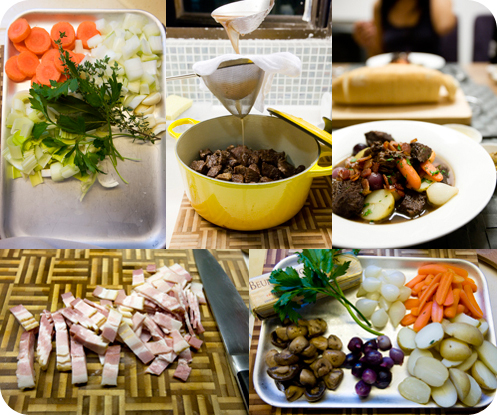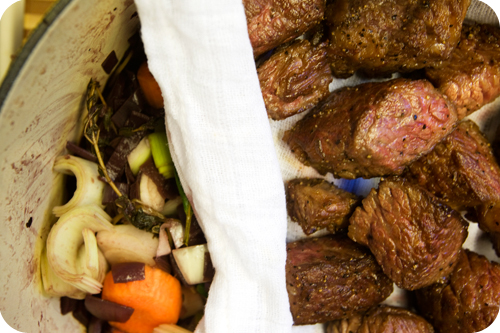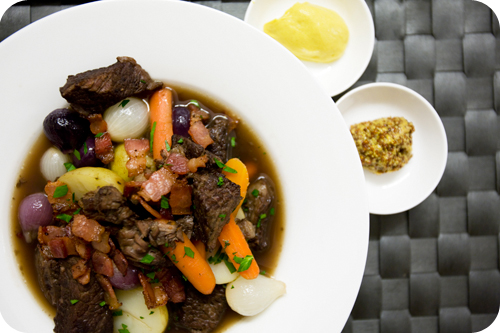Monday, October 27th, 2008...12:20 pm
Boeuf Bourguignon

Most people don’t buy The French Laundry or Bouchon cookbooks to cook from them. Actually, who am I kidding? Most people don’t buy TFL or Bouchon cookbooks full stop. Of those of us who do shell out for it, we’re normally caught up drooling over the pictures, imagining the flavours and textures in your mouth should you one day be so lucky to visit New York or Napa Valley. Those of us who live halfway around the world anyway. Then of course you have the very special few like Carol Blymire who has cooked every single recipe from TFL cookbook. And while I don’t aspire to get there anytime soon – I simply don’t know that I can afford it (suffice to say that this recipe has already set me back about HK$600, not counting the veal stock), nor can I be bothered – it just goes to show that recipes from either of Chef Keller’s tomes are far from impossible for the amateur home cook.
The only recipe I’ve tackled before this was one for brioche – that buttery, eggy, rich, delectable bread. It didn’t go 100% according to plan, and since then I’ve been a little wary of trying any other recipes. However, when J bestowed me with Bouchon for my birthday last month, I found a wealth of recipes which felt a lot more accessible. I decided to start here, and slowly work my way up.

The recipe for Braised Beef with Red Wine is insanely long. I love long recipes because they usually explain the entire process and it leaves less room for mid-recipe head-scratching, but it also means I’m not going to type it out here. You can probably find it online somewhere, but if you can’t, I recommend you go out and get a copy of this book anyway. There are a tonne of recipes I can’t wait to try, and I’m pretty sure you’ll feel the same way too.
Now, proteins braised in wine (or any other liquid) is really not an uncommon method of cooking. You season and brown meat (sometimes dusted with flour before browning), then you pop it into a low oven (or keep it on the stove over a low flame) for a loooooong time with enough of your preferred liquid to cover the meat with a mirepoix of aromatics – usually onions, carrots, leeks, or celery and some herbage. Then the braise is served with some complementary starch or other (potatoes – roasted, mashed, or boiled, rice, bread, polenta etc), with the braising liquid normally clarified and thickened into a velvety sauce.

What I found interesting about this recipe, however, was that the beef – once browned – is kept separate from the aromatics and vegetables by means of cheesecloth. Once the cooking process is over, the meat is then removed, then the sauce degreased and strained back over the meat, and the meat is left to cool and be refrigerated for a day or two so it soaks up all the flavour and deliciousness from the sauce. When ready to serve, new vegetables (baby carrots, pearl onions and fingerling potatoes) are cooked separately and then served with the meat and sauce after it is reheated. This enables you to serve a stew that is fraught with bright colours and bursting with flavour, without having to add different ingredients like in a gremolata.
Also, as stated in the recipe, the constant degreasing and refinement of the dish during each step of the cooking process results in a very vibrant and healthful stew. No sluggish, stodgy thickeners dulling the flavour of the final sauce, and it doesn’t have cloying fat globules which coat the inside of your mouth.

This is probably one of the best stews I’ve ever made (or eaten) in my life. It was rather troublesome to make, needing a minimum of 3 days before I could serve it (Day 1: Make Veal #1 and #2, Day 2: Combine Veal #1 and Veal #2 and reduce to get Veal #3, make stew, refrigerate, Day 3: cook garnishes and serve), and I dragged the process out for almost a week so that I wouldn’t have to slave constantly. But was it worth it? Yes. 100% worth it. The only thing I wish is that it didn’t end up costing me quite so much – a situation that would be alleviated by my local supermarkets letting me choose exactly how many carrots, onions, leeks and garlic I want to buy, and especially if varieties available in small amounts weren’t all flown from halfway around the world, increasing the price I ended up paying.

4 Comments
October 27th, 2008 at 3:21 pm
YUMSY PATUMSY :)
October 30th, 2008 at 6:37 am
Yummers, marbled veal! And a healthy handful (or several) of some fresh herbs!
It’s getting mighty cold down this side of the world and I might just whip this one up for the hungry housemates.
I love your food writing as well, by the way :)
October 30th, 2008 at 11:54 am
Thanks for the visit and comment, Matt! This stew really was AMAZING, I’d definitely recommend that you give it a go. :) Have you got access to the recipe?
November 14th, 2008 at 6:03 pm
that stew looks wonderfully comforting – perfect for our cold nights here!